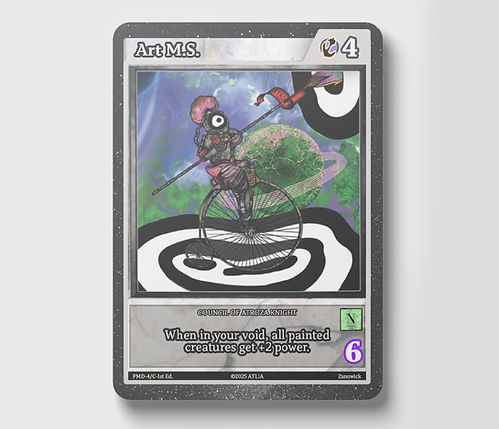
ATLIA's gameplay is designed to be both strategic and accessible. Players build their decks by selecting cards that represent characters/creatures and utility cards. The combination of these cards creates a unique play experience for each game.
The Basics of ATLIA
Before diving deeper, let’s cover the basics of ATLIA. The game is played with a deck of cards, typically consisting of 40 to 60 cards. Each player starts with a set number of core points, and the goal is to reduce your opponent's core points to zero. The goal is to get 10 direct attacks on these core points so destroying your opponent's character/creatures to get to these points is the goal.
You'll need five R20 dice as well when playing the game of ATLIA.
Building Your Deck
When building a deck in ATLIA, players must consider several factors:

Portal Master Cards: Choosing the right Portal master is crucial. Each character has strengths and weaknesses that can influence the outcome of a match. After the first match you can change your portal master up to two times in between the remaining matches.


World Cards: You can only pick one world card during a game. This card works with your deck and portal master to build strategy. It will represent the world and the people you are building your decks around. This card will have a unique ability that can help launch your portal masters' effects that will interact with your whole deck.


Character/Creature cards: These cards will be the bulk of your deck and is how you will battle other portal masters in the game. When you attack another creature if the stronger monster attacks the opponent's monster is destroyed. If you attack an opponent's character/creature and it's stronger than your attacking monster your monster is destroyed but you reduce your opponent's attack power by the attacking character/creature by the difference. Take an R20 dice to represent the new power level.


Utility Cards: These can turn the tide of battle. Players must decide which utility cards to include based on their strategy and the characters they have chosen. You can build around architypes that represent an army type or just random its completely up to the player.


Portal Cards: Every card has a number in the right top corner that will show you how many portal cards you'll need to activate the card each player is trying to use. Each player starts off with 10 portals and on the beginning of each turn you get to add one portal card to your active portal zone.

Understanding these card types is crucial for building a balanced deck that can adapt to different strategies. Creating a deck in ATLIA is an art form. It requires a blend of strategy, creativity, and a bit of luck. Here are some tips to help you build a competitive deck: Know Your Strategy Before selecting cards, decide on a strategy. Do you want to play aggressively, focusing on dealing damage quickly? Or do you prefer a defensive style, controlling the board and outlasting your opponent? Balance Your Cards A well-rounded deck typically includes a strong portal master, mix of character/creatures, and utility cards. This balance allows you to respond to various situations during a match. Test and Tweak Once you have a deck, playtest it against friends. Take note of what works and what doesn’t. Don’t be afraid to make changes. The best decks evolve over time.

The Flow of the Game
The flow of a typical ATLIA game involves several phases:
-
Draw Phase: Players draw 1 portal card from their decks to build their pool of portals.
-
Action Phase: Players can play characters/creatures and use utility cards. This phase is where strategy comes into play, as players must decide how to best use their resources.
-
Battle Phase: Players engage in combat, using their characters/creatures to attack opponents. The outcome of battles is determined by the characters' abilities and the strategies employed.
-
End Phase: Players resolve any lingering effects and prepare for the next turn.
-
Draw Phase 2: Players draw 2 cards from their decks to build their hand at the end of each turn.
Each player can respond with Utility cards on their opponent's turn. This however will tie up those portals on your next turn. You can only restore the portals back to Active Portal zone on that next turn reset.
This structure allows for dynamic gameplay, where each decision can lead to different outcomes. Players must think critically and adapt their strategies based on their opponents' moves.
.jpg)
Final Thoughts
ATLIA is more than just a trading card game; it is a vibrant universe filled with adventure, strategy, and community. Whether you are a newcomer or a seasoned player, there is always something new to discover.
As you embark on your ATLIA journey, remember to enjoy the process. The thrill of building a deck, the excitement of a match, and the camaraderie of fellow players are what make ATLIA truly special.
GO ON AND SAY "HI" AND MAKE NEW FRIENDS AMONGST OTHER GREAT ATLIA PLAYERS.
